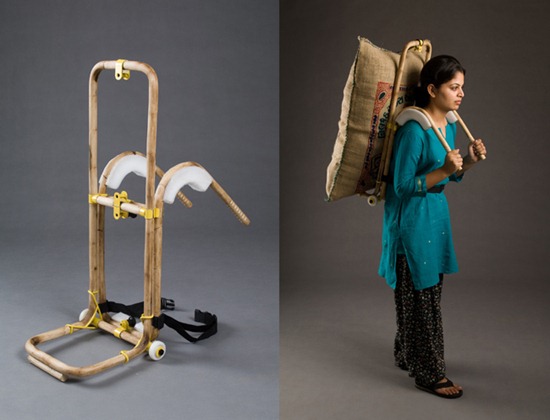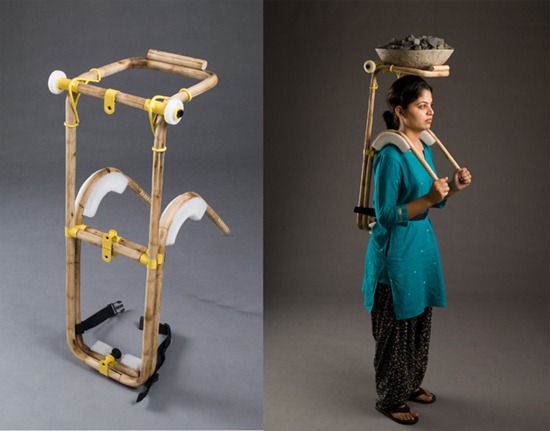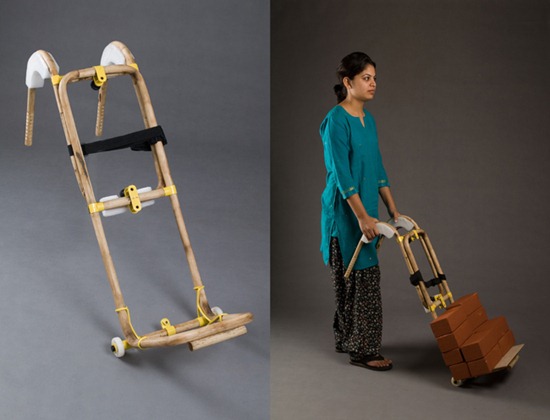| Industrial Design Centre, IIT Bombay
Powai, Mumbai 400076
India
Phone: 91-22-576 7801
Fax: 91-22-576 7803
Contact: Office@idc.iitb.ac.in
Programs: Doctoral programme in Design (Ph. D) as well as 2 year Master of Design (M.Des) in Industrial Design
Admission: open to graduates of Design, Architecture and Engineering + Ceed + Interview
National Institute of Design, Ahmedabad
Paldi
Ahmedabad, Gujarat, 380 007
India
Phone (079) 663 9692 / 660 5243
Fax (079) 662 1167
e-mail : academic@nid.edu
Undergraduate Program: 4 year Graduate Diploma Programme in Industrial Design (GPD) with specialisations in Product Design, Furniture and Interior Design, Ceramic & Glass Design
Admission: open to students who have passed or who will appear for qualifying examinations under the Higher Secondary (10+2), or equivalents like AISSCE/IB/ICSE etc + Entrance Examination + Interview.
Post Graduate Program: 2 and 1/2 year Post-Graduate Diploma Programme in Industrial Design (PGPD) with specialisation in Product Design, Furniture and Interior Design, Ceramic & Glass Design and Toy Design
Admission: open to graduates of Architecture and Engineering + Entrance Examination + Interview
North Guwahati
781039, India
Tel: 0361-690321 to 28
Fax: 0361-690762
Contact: dod@iitg.ernet.in
Department of Design, Guwahati
Indian Institute of Technology, Guwahati
Admission: open to students who have passed or who will appear for qualifying examinations under the Higher Secondary (10+2), + JEE
Undergraduate Programs: 4 year Bachelors of Design in Industrial Design and Communication Design
Post Graduate Program: 2 year Master of Design M.Des in Industrial Design and Communication Design
Admission:open to graduates of Design, Architecture and Engineering + Ceed + Interview
Indian Institute of Technology, Delhi
Instrument Design and Development Centre
IIT Delhi,
Hauz Khas,
New Delhi 110016 India
Tel: 011-666979
Contact: arpgsr@admin.iitd.ernet.in or ind_design@safe-mail.net
Programs: 2 year Master of Design M.Des in Industrial Design
Admission: open to graduates of Design, Architecture and Engineering + Ceed + Interview
Indian Institute of Technology, Kanpur
Design Programme,
Kanpur 208016, India
e-mail: head_des[at]iitk.ac.in, aray[at]iitk.ac.in
Tel: +91-512-2597048
Programs: 2 year Master of Design M.Des in Industrial Design
Admission: open to graduates of Design, Architecture and Engineering + Ceed + Design Test + Interview
Centre for Product Design and ManufacturingCPDM
Indian Institute of Science,
Bangalore 560012 India
Tel: 091-80 - 2293 2359
Contact: office@cpdm.iisc.ernet.in
Programs: 2 year Master of Design (M.Des) programme in Product Design and Manufacturing and
Design Research Program both at M.Sc. ( Engg.) and Ph D level
Admission: open to graduates of Design, Architecture and Engineering + Gate or Ceed + Design Test + Interview
Department of Industrial Design, N Delhi
School of Planning & Architecture, 4,Block-B, I.P.Estate,
New Delhi - 110002, India
Phone: +91 011 - 2370 2375 , 2370 2376
E-mail: info@spa.ac.in
Programs: 2 year graduate Programme in Industrial Design (M. Des)
Admission: open to graduates of Architecture + Gate or Ceed + Interview
M S Ramaih School of Advanced Studies , Bangalore
Gnanagangothri Campus,
New BEL Road,
Banaglore-560 054
Fax/Ph: 080-2360 5539/2360 1983/2360 4759
Contact: pm.npd@msrsas.org
Programs: 2 year M.Sc. [Engineering] in Product Design
NTTF School of Post Graduate Studies , Bangalore
Nettur Technical Training Foundation
Post Box No,5857,
Plot No. 23/24 , II Phase Peenya Industrial Area,
Bangalore -560 058.
Phone: +91-80-28393167 Fax: +91-80-51272146
E-Mail : pgschool@nttf.co.in
Programs: 2 year Postgraduate Programme in Product Design & Engineering (PGPDE)
Admission: Graduate in Mechanical / Production / Industrial & Production / Industrial Engineering & Management / Automobile Engineering with a minimum of 55% marks
IILM School of Design, Gurgaon
Plot 69-71, Sector 53,
Near DLF Golf Course,
Gurgaon - 122003 (NCR-Delhi.)
Phone: 011-33330132, 0124-3096874
Contact: adm@iilminstitute.org
Programs: 4 year graduate programme in Product Design, Communication Design, and 2 year Post Graduate program in Communication Design, Product Design, Interior and Furniture Design, Animation Design, Exhibition Design and Textile Design
Admission: Undergraduate programs open to students who have a pass in Pre-University 10 + 2 Examination
MAEER's MIT Institute of Design, Pune
"Rajbaug", Loni-Kalbhor,
Pune-412201, Maharastra, India
Phone: +91 - 20 39210183/ 91 20 39210122, 9850994211/9822462155
Contact: design@mitpune.com
Programs:
4.5 year Graduate Diploma Programme in Product Design, and Transportation Design
Admission: open to students who have a pass in school 10th + Entrance Examination
2.5 year Post Graduate Diploma Programme in Product Design and Transportation Design
Admission: open to students who have a degree or diploma or its equivalent in any discipline + Entrance Examination
DSK International School of Design, Pune
Survey No. 55/54, Tarwadi, Fursungi,
Pune - Solapur Road,
Pune - 412308, Maharashtra, India
Tel.: + 91 20 66784310 / 66784311
Fax : +91 20 66784317
email id : info@dsksic.com
Programs:
UG: 5 year Certification Programme in Product Design
Admissions: open to 12 std students + Written Test + Interview
PG: 3 years certification program in Product Design
Admissions: open to any degree/diploma/ certificate holder + Written Test + Interview
D J Academy of Design, Coimbatore
Coimbatore Pallachi Highway,
Othakkalmandappam(PO),
Coimbatore 641 032, Tamilnadu, India
Phone: +91 - 4222610428, 2610 33339506224
Contact: office@djad.in
Programs:
4 year Graduate Diploma Programme in Industrial Design and Communication Design
1.5 year Post Graduate Certificate Programme in Product Design
College of Architecture, Nasik Opposite Prasad Mangal Karyalaya
Near Maratha Boarding Complex
Off Gangapur Road,
Nasik 422 013 Maharastra India
Tel : 0253 570822
Contact: admin@cansnashik.com , mvpcans_nsk@yahoo.co.in
Programs: 4 year Bachelor of Design(B. Des) in Product Design , Interior Design, Furniture Design and Set Design
Admission: open to students who have passed 10 + 2 examination
Symbiosis Centre of Design, Pune
Symbiosis Institute of Design [SID]
Viman Nagar, Pune 411 014, Maharastra, India
Phone: +91 20 2663 4547 / 48
Contact: info[at]symbiosisdesign.ac.in
Programs: Graduate Degree Programme in Communication Design, Product Design and Fashion Design
Admission: open to students who have passed or who will appear for qualifying examinations under the Higher Secondary (10+2)
Indian Institute of Information Technolgy, Design & Manufacturing, Jabalpur
Dumna Airport Road,
P.O.: Khamaria,
Jabalpur - 482 005,
Madhya Pradesh, IndiaTel: +91-761-2632273
Fax: +91-761-2632524
email: query@iiitdmj.ac.in
Programs: 2 Year Post-Graduate Diploma Programme in Design
Admission: Open to graduates of Design, Architecture and Engineering + Gate or Ceed + Design Test + Interview
Srishti School of Design, Bangalore
Srishti School of Art, Design and Technology
P.O. Box No. 6430, Yelahanka New Town,
Doddabalapur Road, Opp. Wheel & Axle plant
Bangalore-560 064, India
Phone: 91.80.28462506/07/08, 28560238.
TeleFax: 91.80.28560240
Contact: admissions@srishti.ac.in
Programs: 2 + 2 year Professional Diploma in Industrial Design with focus on Furniture and Interiors
Admission: open to students who have passed or who will appear for qualifying examinations under the Higher Secondary (10+2] + Entrance Examination + Interview.
Indian Institute of Craft and Design, Jaipur-8 , Jhalana Institutional Area,
Jaipur - 302017.
Tel: 0141-2701504, Fax: 0141-2700160
Email: info@iicd.ac.in
Programs: 4 Year Under-Graduate Diploma Programme and 2 year Post-Graduate Diploma Programme in Craft and Design
Admission: Undergraduation open to students who have a pass in Pre-University 10 + 2 Examination and Post-graduate programme for graduates in any discipline.
Centre for Design and Technology, BangaloreCEDT
Indian Institute of Science,
Bangalore 560012 India
Tel : 080 - 23600810, 080 - 22932246
Contact: office@cedt.iisc.ernet.in
Programs: 2 year Master of Technology (M. Tech) in Electronic Design and Technology
Admission: open to graduates of Engineering
Raffles Design International, Mumbai
Raheja Centre,
Linking Rd & Main Avenue,
Santacruz (W) Mumbai 400 054
Tel: 022-5572 6711, 5502 9522, 98190 24429
Contact: rdi-India-enquiries@raffles-design-institute.com1
Programs: 3 year Bachelor of Arts in Design (Product Design) degree programme in Product Design
Admission: 12th Pass with TOEFL scores |
|










